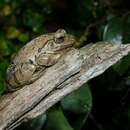en
names in breadcrumbs


Development - Life Cycle: metamorphosis
Other Physical Features: ectothermic ; bilateral symmetry
Key Reproductive Features: gonochoric/gonochoristic/dioecious (sexes separate)
The Rhacophoridae are a family of frogs that occur in tropical sub-Saharan Africa, South India and Sri Lanka, Japan, northeastern India to eastern China and Taiwan, south through the Philippines and Greater Sundas, and Sulawesi. They are commonly known as shrub frogs, or more ambiguously as "moss frogs" or "bush frogs". Some Rhacophoridae are called "tree frogs". Among the most spectacular members of this family are numerous "flying frogs".
Although a few groups are primarily terrestrial, rhacophorids are predominantly arboreal treefrogs. Mating frogs, while in amplexus, hold on to a branch, and beat their legs to form a foam. The eggs are laid in the foam and covered with seminal fluid before the foam hardens into a protective casing. In some species, this is done in a large group. The foam is laid above a water source so the tadpoles fall into the water once they hatch.[1]
The species within this family vary in size from 1.5 to 12 cm (0.59 to 4.72 in).[1] Like other arboreal frogs, they have toe discs, and those of the genus Chiromantis have two opposable fingers on each hand. This family also contains the Old World flying frogs, including Wallace's flying frog (Rhacophorus nigropalmatus). These frogs have extensive webbing between their fore and hind limbs, allowing them to glide through the air.[2]
The Rhacophoridae are the sister group to the Mantellidae, a family of frogs restricted to Madagascar. Both families are thought to have diverged during the Paleocene, although previous studies estimated a Cretaceous divergence. Two different hypotheses for this divergence have been proposed: one that the Mantellidae and Rhacophoridae diverged when Insular India broke from Madagascar, with the Rhacophoridae colonizing the rest of Asia following the collision of India with Asia, and the other proposing that the common ancestors of both families inhabited Asia, with the ancestral Mantellidae colonizing Madagascar from India via long-distance dispersal, using India as a stepping stone.[3][4]

This phylogeny of the Rhacophoridae is from Yu et al. (2008):[6]
Rhacophoridae Buergeriinae RhacophorinaeAs many frogs, rhacophorids harbour monogenean worms in their urinary bladders. The parasite species specialized to this family of frogs belong to the genus Indopolystoma, described in 2019.[7]
The Rhacophoridae are a family of frogs that occur in tropical sub-Saharan Africa, South India and Sri Lanka, Japan, northeastern India to eastern China and Taiwan, south through the Philippines and Greater Sundas, and Sulawesi. They are commonly known as shrub frogs, or more ambiguously as "moss frogs" or "bush frogs". Some Rhacophoridae are called "tree frogs". Among the most spectacular members of this family are numerous "flying frogs".
Although a few groups are primarily terrestrial, rhacophorids are predominantly arboreal treefrogs. Mating frogs, while in amplexus, hold on to a branch, and beat their legs to form a foam. The eggs are laid in the foam and covered with seminal fluid before the foam hardens into a protective casing. In some species, this is done in a large group. The foam is laid above a water source so the tadpoles fall into the water once they hatch.
The species within this family vary in size from 1.5 to 12 cm (0.59 to 4.72 in). Like other arboreal frogs, they have toe discs, and those of the genus Chiromantis have two opposable fingers on each hand. This family also contains the Old World flying frogs, including Wallace's flying frog (Rhacophorus nigropalmatus). These frogs have extensive webbing between their fore and hind limbs, allowing them to glide through the air.